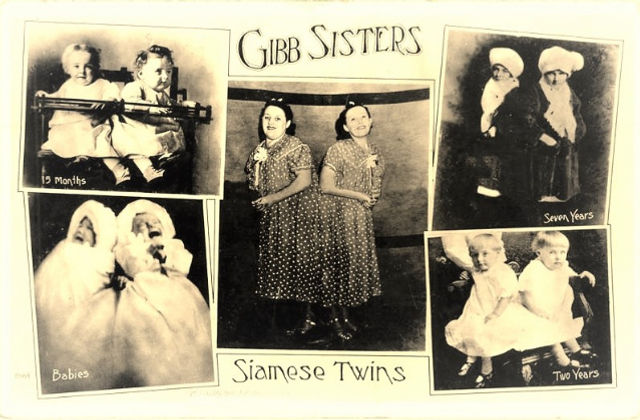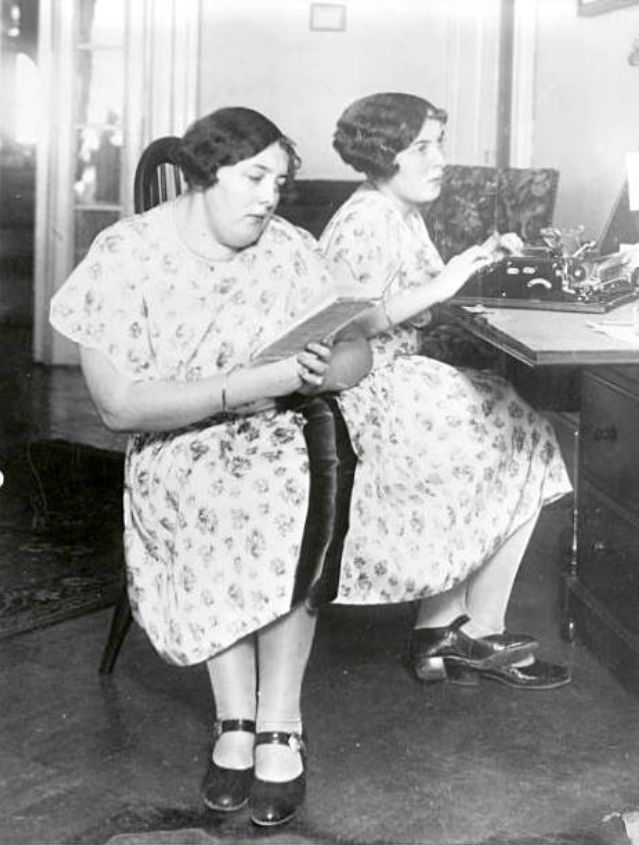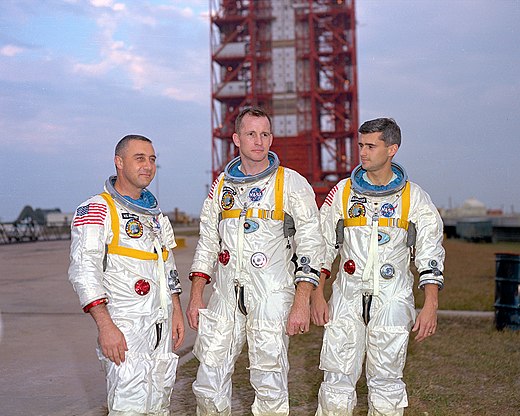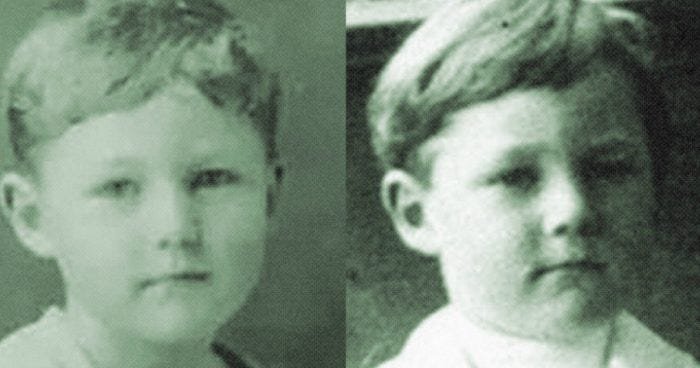Twins are said to have an innate connection to one another. It’s been reported that if one is hurt, the other can feel it. They are also said to be able to read each other’s mind, with plenty of anecdotal evidence to support this theory.
For twins Mary and Margaret Gibb, their connection was more than emotional; it was physical. The twins were born conjoined. They were Pygopagus twins, a rare type of conjoined twin commonly joined back to back at the base of the spine and the buttocks.


Born in 1912 to Margaret Gibb, the twins would go on to become a global phenomenon.
Two Individuals Sharing One Body
When the girls were born, Mary and Margaret’s mother refused offers of surgery to separate her babies. Any attempt to do so carried a high fatality risk, one that their mother refused to consider.
When the girls were toddlers, again, doctors approached the Gibb family with an offer to perform surgery on the conjoined sisters. The offer was promptly rejected.
As the girls grew up, their unique situation didn’t stop them from developing just as any other young girl would. While they were undeniably connected, their organs were all separate, aside from their rectum. They each had their own limbs and learned to adjust in order to walk in sync with one another.
Remarkably, neither twin felt the other’s pain despite the flesh that bound them together. The girls’ personalities became polar opposites as they developed into their teens.
Their mother described their personalities as being like chalk and cheese, describing Margaret as neurotic and worrisome while Mary was much more easygoing.
However, they didn’t attend school like other girls their age and were home-tutored. This didn’t affect their desire to leave home and find independence, which they did at the young age of 14.
Touring The World
The twins moved to New York City to chase their dreams of working in entertainment. They wanted to pursue a career in vaudeville, a Parisian word describing “a farce with music.”
The French form of entertainment became popular In the United States from the mid-1890s until the early 1930s. The show would consist of 10 or more individual acts, often featuring magicians, acrobats, comedians, jugglers, and singers.
The Gibb twins enjoyed performing in front of a crowd and were natural-born entertainers. Their act was soon popular enough to pay the bills.

They got their first real paycheck at the age of 16 when they toured Europe with their vaudeville act. The sisters were known as “America’s Siamese Twins,” and their show brought in many curious customers.
The twins were picked up by the famous Cole Bros and the Barnum & Bailey Circus, which took the girls all over the world.
As they became more notorious and well-known, people often asked why Mary and Margaret didn’t choose to separate. The sisters were determined to remain conjoined despite the many offers that came from surgeons to give them independence.
The surgery – which would have been performed for free – would also gain widespread acclaim for the surgeon who carried it out. As such, the offers came in regularly.
The twins also endured probing from the public as to why they refused to separate, further putting pressure on the pair to undergo the surgery.
When Mary became sick with the flu, the question was posed yet again about the possibility of them going under the knife. Still, the twins were steadfast about remaining conjoined. If one got sick, the other got sick, and that’s just the way it was. The sisters refused to be separated.
The media further propelled their unique story when Margaret began dating at 18. She met Carlos Daniel Josefe while at a show in New Orleans, and the pair quickly applied for a marriage license, which was granted.
Meanwhile, rumors were swirling that this revelation would finally see the twins accept offers to separate them. The rumors turned out to be just that, and again, the twins declined the operation.
Despite the quick courtship, Margaret’s planned 1927 marriage never took place.
When the twins turned 40, they decided to retire from circus life and return to their home city of Holyoke, Massachusetts.
Here, the women decided to make money by selling novelty items, some of which they made themselves. They opened the Mary-Margaret Gift Shoppe, which was filled with unique trinkets, cards, and vases.
Despite the twins no longer touring, they still intrigued the public, and the gift shop became a huge success. Mary and Margaret’s unique situation prompted many customers to visit just to see them. The gift shop remained open until the twins fully retired at almost 50.
As a result, they became reclusive, shunning their former life as entertainers and choosing to remain behind closed doors most of the time. The local community rarely saw the sisters unless they were making their way to or from church. While they enjoyed the quiet life, they watched television and knitted.
As unique and unusual as the Gibb sisters were, they weren’t the only twins who’d attracted worldwide attention in the 1920s.
The Famous Hilton Sisters
Around the same time the Gibb sisters traveled the world, another pair of conjoined twins was also doing the circus circuit.
The Hilton Sisters were arguably more famous than Mary and Margaret, although their story is perhaps more tragic than the Gibb sisters’.
Born in February 1908, Daisy and Violet Hilton were born to an unmarried mother named Kate Skinner. Kate’s boss, Mary Hilton, immediately saw the twins as a commodity and offered to buy the children from the young mother.
Afraid of the twin’s unusual circumstances, Kate agreed to sell the children to her.
However, Mary was not kind to the twins. She saw them as a commercial asset rather than children who deserved to be nurtured. She moved them into a flat above the Queen’s Arms pub in Brighton, where they were exhibited in exchange for money.
As the girls grew up, they endured abuse at the hands of Mary and her husband as they trained them to sing and dance. By age three, the twins were touring the UK as “The United Twins.” Their backstory was given its own “creative” twist to further enthrall paying customers.
The twins eventually took their “show” to America. Mary, who kept all the money she made from the tour, would die while they were performing in Alabama. As a result, the twins were placed in the care of Mary’s daughter, Edith.
Edith and her husband would further abuse the twins. They were beaten if they failed to perform to the couple’s liking. They were held captive in their San Antonio home and were forced to learn the saxophone and violin.
The twins managed to find their freedom in 1931 when they were legally emancipated and awarded $100,000 for their treatment at the hands of their “managers.”
After this, though, their popularity waned. The twins ended up working in a grocery store, where the owner made them a custom cashier station that hid the fact the women were conjoined from customers.
In January 1969, the twins didn’t turn up for work. This was unlike them, and after days of their boss trying to reach them by phone and knocking on their door, the police were called.
They eventually broke the door down and found the twins dead. An autopsy found Daisy had died first, and Violet had succumbed a few days later.
Violet hadn’t tried to call 911 or seek help despite being stuck next to her dead twin for days. They are buried together in Forest Lawn West Cemetery in Charlotte.
Just a few years prior to this, the Gibb sisters had also been overwhelmed by illness.
The Gibb Sister’s Final Days
Margaret was diagnosed with bladder cancer in 1966 when the pair were in their early 50s. Despite the seriousness of the illness, the sisters still remained adamant that they didn’t want to be separated.

Even when they were told that the cancer would more than likely spread to Mary, too, the women shut down any kind of medical intervention that was offered.
The cancer would spread rapidly and aggressively, as predicted. Even so, the sisters refused to be separated, even if it meant Mary could be spared.
By 1967, the cancer had reached Maragaret’s lungs. That August, she passed away. Mary died just moments later. The twins were 55.
Mary and Margaret had been adamant that they still wanted to remain together even after they died. A special coffin had to be made to accommodate their wishes, and they were buried together next to their mother.
The quote “til death do us part” is perhaps inaccurate in this instance since Mary and Margaret never parted ways, no matter how much pressure they were under to do so. Even in death, they remain together.
Sources
https://www.findagrave.com/memorial/7028426/margaret_and_mary-gibb
https://www.dannydutch.com/post/the-life-and-times-of-conjoined-twins-margaret-and-mary-gibb












Leave a comment